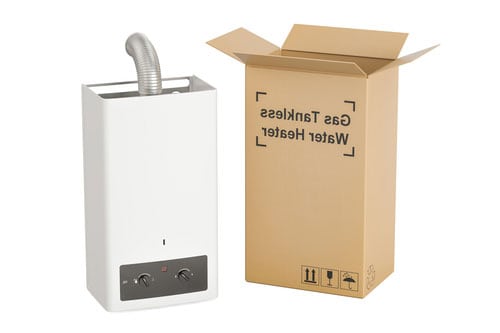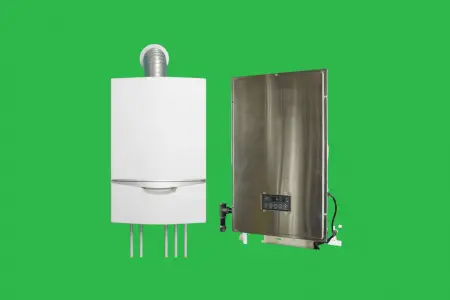As more and more people are turning to tankless water heaters for their efficiency, there is a very common question:
Which kind of tankless water heater is the most efficient? Condensing vs non condensing?
The simple answer is that a condensing tankless water heater is more efficient than a traditional non condensing one.
Why is that?
Well, I’ll go into all the details about the benefits of a condensing on demand water heater as well as some of the drawbacks.
Suffice it to say a condensing unit doesn’t emit nearly as much exhaust so a lot of heat loss that you experience with a non condensing inline water heater doesn’t happen.
Here are some of the best selling condensing tankless water heaters on Amazon.
And then here are the top selling gas tankless heaters overall.
What is a Condensing Tankless Water Heater?
A condensing tankless water heater is simply a tankless model that doesn’t release the condensation caused from heating the gas out through the exhaust.
See, in a traditional type of model, the water is heated with gas and the steam that is caused by the combustion gets vented outside where it dissipates into the air.
A condensing unit cools this steam before it exits and then it condenses, hence the name.
What happens to the condensate?
There is a second heat exchanger besides the primary one that heats the water. The second one then heats the cooled condensate and circulates it to the pipes leading to the primary heat exchanger.
This warms the water on its way to the primary heat exchanger so it doesn’t take as much fuel to heat it up.
You can see where this is going.
This is the primary benefit, so let’s dive in and explore some other advantages to the condensing tankless water heaters.
How does a condensing tankless water heater work, you ask? Watch this video below for an easy to follow guide.
Some of the best condensing tankless heaters are made by Rinnai. They are the top of the line for either type but have really nailed the condensing technology.
Check out my article on the best Rinnai tankless water heaters to learn all about them as a brand and see which ones really stand out.
Benefits of a Condensing Water Heater
Efficiency
As the end of the last section illustrated, there are some serious efficiency advantages to using a condensing water heater.
Since the heat from the steam is recycled, you lose a lot less heat in the process. In fact, traditional non condensing tankless water heaters lose about 20% of their heat out the exhaust vent.
When you see a rating of 80% for a tankless water heater, that is what this number means. It is able to retain 80% of its heating capacity to heat the water. The rest goes out the vent.
A condensing unit is able to maintain a rating of up to 98%!
Almost all of the fuel is used to actually heat the water with a paltry 2% being lost.
If you need more information on tankless water heaters in general, check out my article on the pros and cons of on demand water heaters!
Condensing Tankless Water Heater Venting
When a traditional tankless vents the steam, it comes out quite hot. So to vent it safely, you have two option. Either use a more expensive concentric venting system in which an interior vent expels the hot exhaust while it is enclosed by another vent that draws in the cooler air.
Or, use a corrosion free stainless steel that is expensive in itself and also can’t be sealed with regular sealant, adding to the expense.
Condensing model venting can be made out of much cheaper PVC since whatever exhaust doesn’t get recycled comes out much cooler. It won’t heat up the vent so you can save a lot on a non specialized PVC pipe which can also be sealed cheaply.
If you want more information about the types of venting kits available that you’ll need, I wrote a detailed article to help you out. Just click here and save the article for when you are ready to buy your tankless heater.
Cost Savings
Since condensing tankless water heaters are generally more expensive than the non condensing, this can be considered a push.
Which in my mind, is a good thing.
Typically, you can save about 10 to 20% off of your gas bill compared to other traditional tankless water heaters. This is on top of what a tankless vs a tank system already gives you.
Add in the savings from using PVC piping and it really makes a difference. The higher cost of the unit is then offset with the savings meaning it really doesn’t end up costing you more for the condensing style model.

Disadvantages
Condensing units cost more
A typical tankless water heater has a lot of complicated engineering that goes into it. This is why they usually cost more than a tank storage system.
Now, add the more complex recycling needs of a condensing tankless water heater.
First of all, there is a second heat exchanger. This adds to the cost.
Then, the primary heat exchanger must be out of a non corrosive stainless steel rather than the typical copper.
Since the condensate is so acidic, it can corrode the inner workings of the unit, so higher grade materials need to be used.
More Maintenance
Flushing out a tankless hot water heater to descale it from hard water is something that you need to do once per year whether it is a condensing or non condensing type.
But, in addition to that, you have to neutralize the condensate that drains into your house pipes and into the city system.
The condensate is highly acidic so this is not only a good idea, but also may be required depending on your city ordinances.
So you’ll need a neutralization box that will have to be recharged every year. Once a year you will need to check the pH of the media inside the box and if it is under a certain amount, then you’ll need to change it.
Usually it’s limestone or marble chips so it isn’t something expensive. It’s just one more thing you need to do.
Condensing tankless water heater drain
Some people buy condensing units without even realizing what the means and end up thinking that they are leaking and something is wrong. When you install a condensing tankless water heater, you need to have a drain there.
If you have a high BTU tankless water heater, and high water demand, you can see upwards of a gallon of condensate drain per hour
If that ends up on your basement floor, or worse, if you have it installed in a closet, then you’re going to have quite a mess on your hands.
Make sure if your plumber installed your unit that he also put a length of piping leading to a drain.
You’ll need a condensate neutralizer box to avoid having a corrosive liquid draining freely into your pipes. You can buy one from Amazon like this Noritz NC-1 if your unit doesn’t already come with one.
Learn More
When it comes to condensing tankless water heaters and draining the condensate, you can easily make your own neutralizer capsule. You have to neutralize the drainage water since it is highly corrosive so save a few bucks by following my step by step guide if you click that link to the full article.
Are Condensing Tankless Water Heaters Worth It?
It sounds like a lot to think about making sure the drain is right and that you are checking and refilling your condensate box periodically.
But, with the cost of fuel rising all the time, it makes sense to save when you can.
Since you can expect some extra savings from a condensing unit on top of what you’re already getting from a traditional tankless, then they definitely make sense.
If you have the extra cash in your budget when you are ready to buy, then you should really look into one.
In my opinion the winner of condensing tankless water heater vs non condensing is pretty clear, even with the extra cost and maintenance.

Nick Lopresti is the founder of YourH2Home and a home improvement expert. He has years of experience writing about various home improvement topics, mostly as it pertains to water systems.




